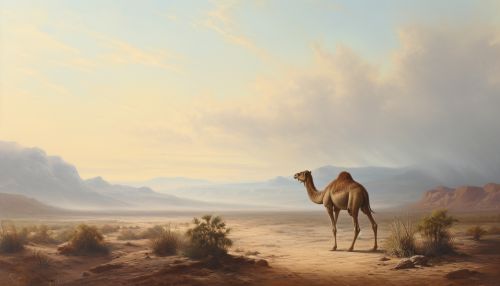Dromedary
Taxonomy and Naming
The dromedary, also known as the Arabian camel, is a large, even-toed ungulate with one hump on its back. Its scientific name is Camelus dromedarius. The term "dromedary" is derived from the Greek word "dromas", meaning "runner". The dromedary belongs to the family Camelidae, which also includes the Bactrian camel and the wild Bactrian camel.
Description and Anatomy
Dromedaries are large animals, typically standing 1.8-2 meters (5.9-6.6 feet) at the shoulder and weighing between 400-600 kilograms (880-1,320 pounds). The most distinctive feature of the dromedary is its hump, which is used to store fat that can be converted into water and energy when food and water are scarce. The dromedary's coat varies in color from a light beige to dark brown.


The dromedary has several adaptations for life in arid environments. Its long legs help to keep its body away from the hot desert surface, and its broad, tough feet are well-suited for travel on sand. Its eyes are protected from sand and dust by a double row of long eyelashes, and its ears are lined with fur for the same purpose. The dromedary's nose is able to trap moisture from its exhaled breath, reducing water loss.
Distribution and Habitat
Dromedaries are native to the arid regions of the Middle East and North Africa. They have been introduced to other parts of the world, including Australia, where they are now considered an invasive species. Dromedaries prefer desert conditions, but they can also be found in grasslands and savannas.
Behavior and Ecology
Dromedaries are social animals, typically living in herds of up to 20 individuals, consisting of one dominant male, several females, and their young. They are primarily active during the day, and they spend the majority of their time foraging for food and water.
Dromedaries are herbivores, feeding on a variety of plants, including grasses, leaves, and shrubs. They are able to consume food that is too dry or salty for most other animals, thanks to their specialized digestive system.
Domestication and Uses
Dromedaries have been domesticated for thousands of years and are used for a variety of purposes, including transportation, milk production, and meat production. They are also used in racing and as beasts of burden in desert regions, thanks to their ability to carry heavy loads for long distances without water.
Conservation Status
The dromedary is not currently considered to be at risk of extinction. However, wild populations are declining due to habitat loss and hunting. Conservation efforts are focused on protecting remaining wild populations and their habitats.
